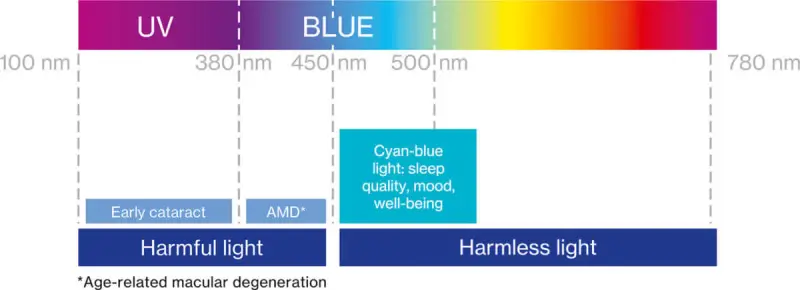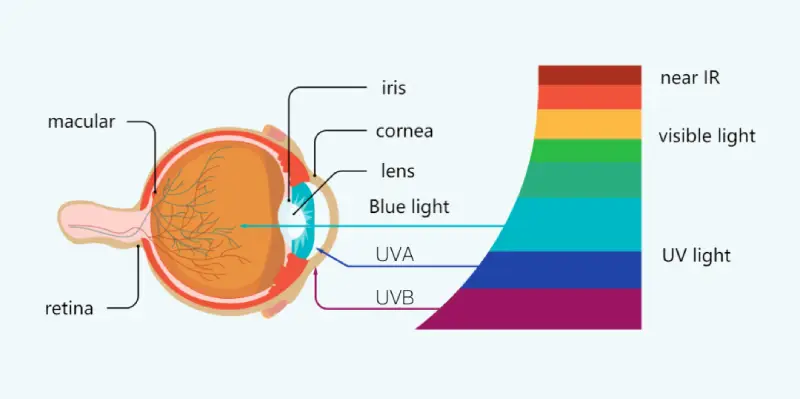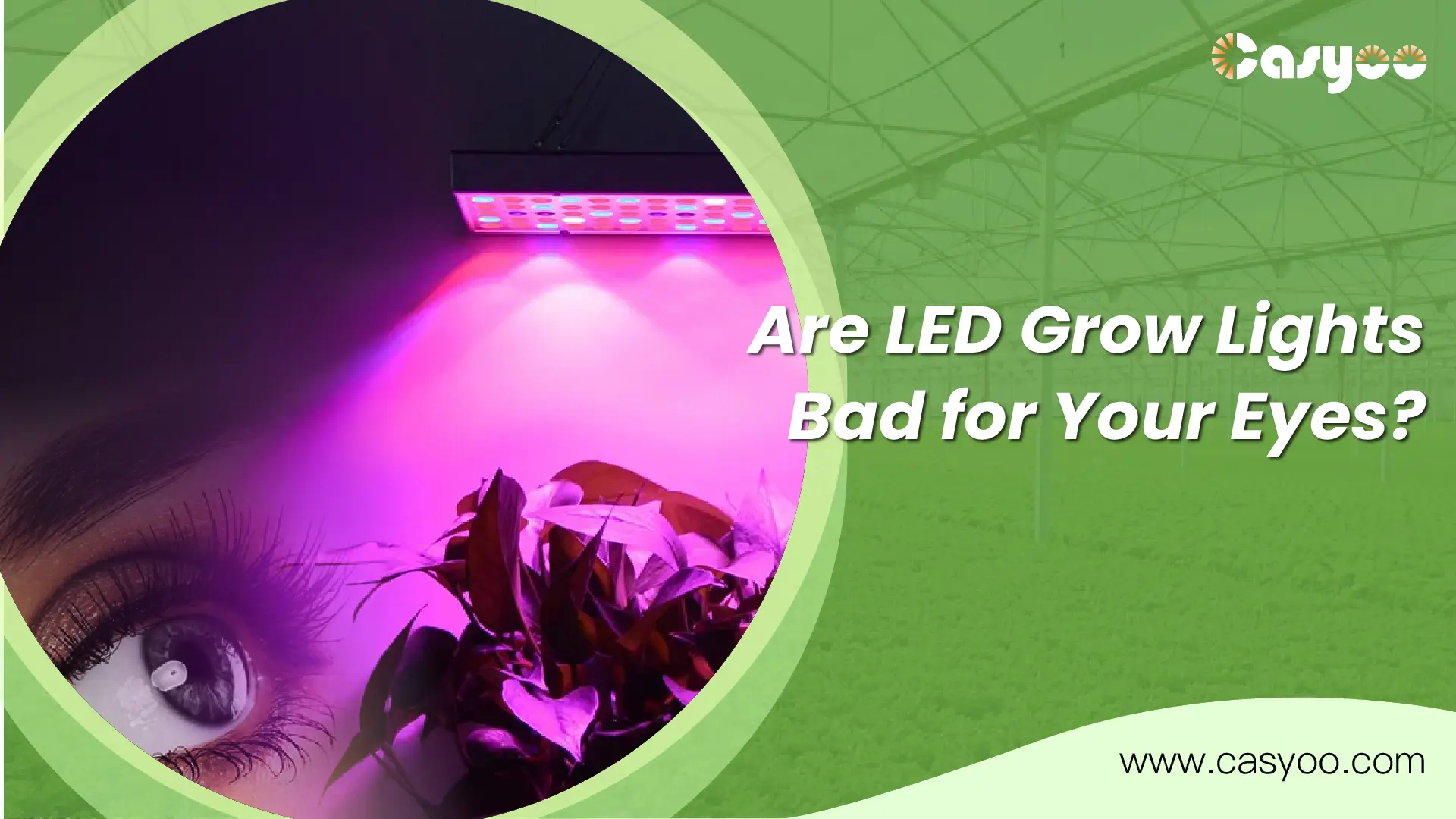Are LED grow lights bad for your eyes? The short answer is: not if used correctly. While LED grow lights emit some blue light and UV radiation, the levels are typically low and not enough to cause significant harm under normal use. However, prolonged exposure to intense light can still lead to eye strain or discomfort, especially if you’re working too close to the lights. In this article, we’ll break down the risks and provide you with simple tips on how to keep your eyes safe while growing healthy plants indoors.
How do eyes process light?
The way the human eye processes light is complex. Simply put, photoreceptor cells, namely rods and cones, allow us to see clearly and distinguish colors, motion, and shapes. They are all stimulated by different wavelengths. This is why natural or white light allows humans to see clearly.
The human eye can only see a small part of the full electromagnetic spectrum, which exists between the shorter wavelengths of ultraviolet (UV) and the longer wavelengths of infrared light. UV and blue light are of the greatest concern.
Do LED grow lights hurt the human eye?

Intensity, wavelength, and duration affect the safety of any grow light. If we look directly at the light, any intense light can harm our eyes, but it is easily avoided by not staring at your light.
For example, you stare at the bright light. When you blink, a brief glance can cause strange patterns in your vision. Staring at it for an extended period can hurt your eyes. This is true of any bright light, whether LED or traditional fixtures. Also, being too close to plants can burn them. Learn ideal hanging heights in our LED grow light distance guide.
Most wavelengths are harmless. However, LED grow lights that emit UV rays and blue light are harmful to your eyes. This includes fluorescent grow lights, HPS grow lights, and MH grow lights. On the other hand, pure red light is harmless unless the intensity is very high.
Do LED grow lights emit UV light?
Yes. Due to the use of additives and phosphors in the manufacturing process, LED grow lights emit low levels of UV radiation, mainly UVA. However, this amount of UV radiation is safe and can contribute to healthy plants. In addition, these lights emit very little UVB, which is far below the safety limit.
What effects do UV rays have on the eyes?
Concerns about ultraviolet rays are related to the increase in eye diseases such as cataracts. Cataracts impair millions of people’s vision and drive up medical expenses annually by billions of dollars, even though they can be cured with modern eye surgery.
What effects does blue light have on our eyes?

Blue light is the energy-rich part of the electromagnetic spectrum with a wavelength range of between 380 and 500 nm. Blue light is omnipresent, be it in sunlight or grow lights. It has relatively high energy and has a significant effect on the development of crops. Essentially, blue light serves as a growth regulator.
The wavelength of blue light is the shortest, which means it has the most damaging power. The photoreceptor cells in the retina can be harmed by excessive blue light, leading to macular degeneration and even irreversible vision loss. Nevertheless, unless you are exposed to too much blue light, this is uncommon. But it is always better to be cautious, blue light will have a negative impact on our vision anyway, and our corneas are not very good at blocking blue light. Therefore, it is vital to take measures to protect our eyes.
What effects does LED light flickering have on the eyes?
Prolonged exposure to LED light flickering can cause symptoms such as eye movement dysfunction, double vision and headaches. In addition, LED light flickering can affect our productivity, concentration, comfort, and even emotional well-being. With long-term exposure to flicker, you may suffer from persistent headaches and migraines, and even cause epileptic seizures in non-epileptic patients.
LED light flickering can be easily solved by replacing or upgrading bulbs, or dimmer switches. For more details, click here.
Is sitting close to a grow light safe?
Sitting next to a grow light, especially one with high intensity, is generally not recommended for extended periods. Long-term exposure to the light can result in pain and possible harm, even though it might not cause damage right away. Grow lights, particularly those emitting blue light or UV rays, can cause eye strain, fatigue, and even long-term damage if you’re too close for too long.
It’s also important to remember that grow lights are designed to be positioned close to plants to ensure healthy growth. They aren’t meant to be your room’s main source of illumination. To ensure both your plants and your eyes stay safe, position the lights appropriately to avoid unnecessary exposure.
How to protect your eyes in a grow room?
Don’t look directly at the light.
Blue light and UV light can be harmful to our eyes. The degree of harm caused by LED lights is related to the spectrum and intensity. Any strong light will cause damage to your eyes if you look directly at it. So the method of eye protection for LED grow lights is simple, don’t stare at your lights.
Wear grow glasses, not sunglasses
If you are a professional grower, steer clear of using regular sunglasses. They don’t effectively block specific intense wavelengths like blue light, and cheaper ones might not even filter out UV light. Additionally, wearing them makes it challenging to accurately observe your crops, as they can distort the colors that are crucial for monitoring plant health.
Professional LED grow light protective glasses will make your plants look completely natural with them. This makes it easier to check your crops and detect any signs of problems in time.
Use a light-blocking grow tent
A light-blocking grow tent can help create a safe environment by reducing the intensity of light exposure. It helps minimize potential harm from the powerful light emitted by grow lights, keeping both your eyes and your plants in optimal condition.
How close is too close to LED grow lights?
Be careful not to get too close to your grow lights. A distance of at least 3 feet will help reduce the light intensity and protect your eyes from potential strain or damage. Keeping this distance also helps your plants thrive without excessive heat or light intensity.
LED Grow Lights FAQ
Q: Are HPS grow lights bad for your eyes?
A: Using Indoor HPS grow lights exposes individuals to damaging UVA, UVB and UVC rays that harm their vision. If you grow crops with HPS grow lights, you should buy a pair of HPS grow room glasses, as regular sunglasses do not provide UVC protection.
Q: Are purple LEDs bad for your eyes?
A: Your eyes may become strained because of long-term purple LED exposure, especially when these lights contain powerful blue wavelengths. Reduce the risk by limiting your exposure to light and never stare directly into the light.
Q: Are indoor grow lights safe in my room?
A: Most grow lights represent no safety threat, but long-term exposure to specific types including intense blue or flickering light may lead to vision strain and headaches. If you are concerned about whether grow lights are safe for humans, make sure the light is shielded and maintain a safe distance from it.
About us
Casyoo has more than 17 years of experience in the LED grow light industry. The grow lights from Casyoo provide three vital features for reducing eye strain through optimal brightness, uniform illumination, and UV protection shielding. Whether you have questions about grow lights or want to seek advice, feel free to contact us. Casyoo is 24/7 available to help you.




